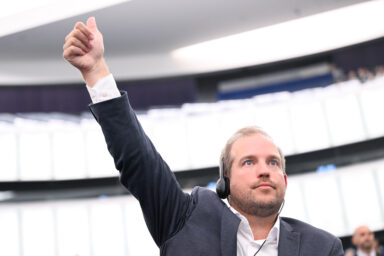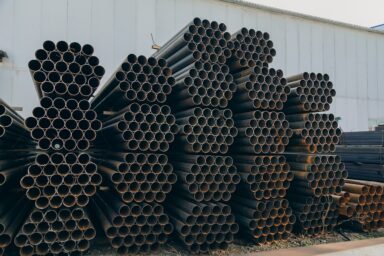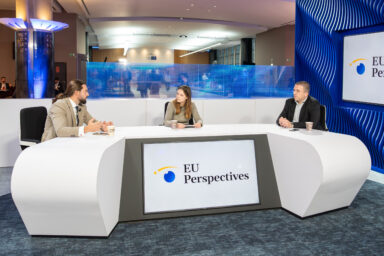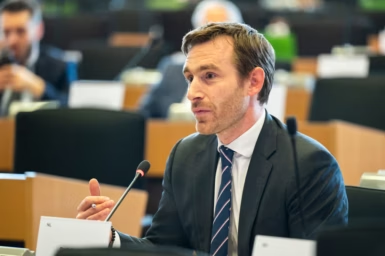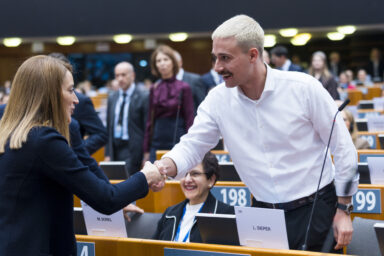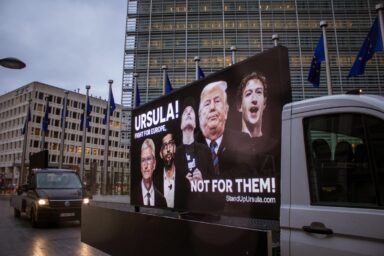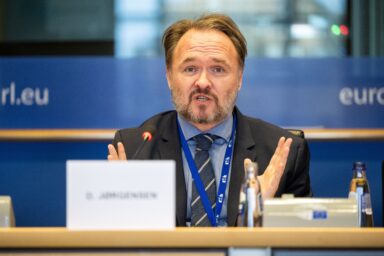When Russia invaded Ukraine in February 2022, Europe’s defence sector—long accustomed to peacetime rhythms—was jolted awake. Now, the challenge lies in scaling an industry hamstrung by fragmentation. Yet military capability requires industry capability, says Burkard Schmitt, Security and Defence Director of the Aerospace, Security and Defence Industries Association of Europe, or ASD. On 14 May, he debated the lingering challenges of continental rearmament in the EU Perspectives podcast with MEP Jan Farský (EPP/CZE) and economist Juan Mejino-López, research analyst at the Bruegel think-tank.
For an industry lulled by national governments placing modest, sporadic orders for equipment calibrated to low-intensity conflicts, the sudden demand for mass production of advanced weaponry has been a shock to the system. “Everyone was taken by surprise,” ASD’s Burkard Schmitt told his fellow podcast debaters, “even though we should not have been; there were signs.” The Russian invasion in Ukraine laid bare a harsh truth: Europe’s defence-industrial base, structured around national programmes and incremental upgrades, was woefully unprepared for a continent-wide rearmament drive.
The roots of this vulnerability stretch back to the post-Cold War era. Defence budgets across Europe dwindled as governments redirected funds toward social programmes and infrastructure. Procurement became reactive rather than strategic—replacing ageing kit piecemeal rather than investing in next-generation systems. “We operated in a peacetime modus,” says Mr Schmitt. (Production lines at firms like Rheinmetall, Leonardo, or Saab were optimised for small batches, often customised to national specifications; a German Leopard tank might differ from a Spanish variant in its communications systems or armour composition, complicating interoperability and inflating costs).
Peacetime hangover
This fragmentation, Mr Schmitt argues, left the sector ill-equipped to pivot when the war in Ukraine triggered a surge in demand. The challenge is not merely technical but structural. Europe’s defence industry remains a patchwork of national champions, each jealously guarded by governments reluctant to cede control.
While NATO sets broad capability targets, implementation is fractured. “Member states go back home and do things in their own way,” Mr Schmitt explains. A French drone programme might overlap with a German initiative, while Poland prioritises artillery systems over naval assets. The result is duplication, inefficiency, and a failure to aggregate demand. “Small production volumes drive up unit costs,” the German defence expert says. “From an industrial perspective, joint procurement isn’t just desirable—it’s essential.”
You might be interested
The transatlantic comparison is stark. The United States’ defence-industrial base, bolstered by decades of sustained investment and a political commitment to “absolute dominance and autarchy,” as Mr Schmitt puts it, operates at a scale Europe struggles to emulate. American firms like Lockheed Martin or Raytheon benefit from economies of scale, with the Pentagon acting as a single, deep-pocketed customer. “The U.S. views its defence industry as a strategic asset,” says Mr Schmitt. “Europe never had such an ambition.”
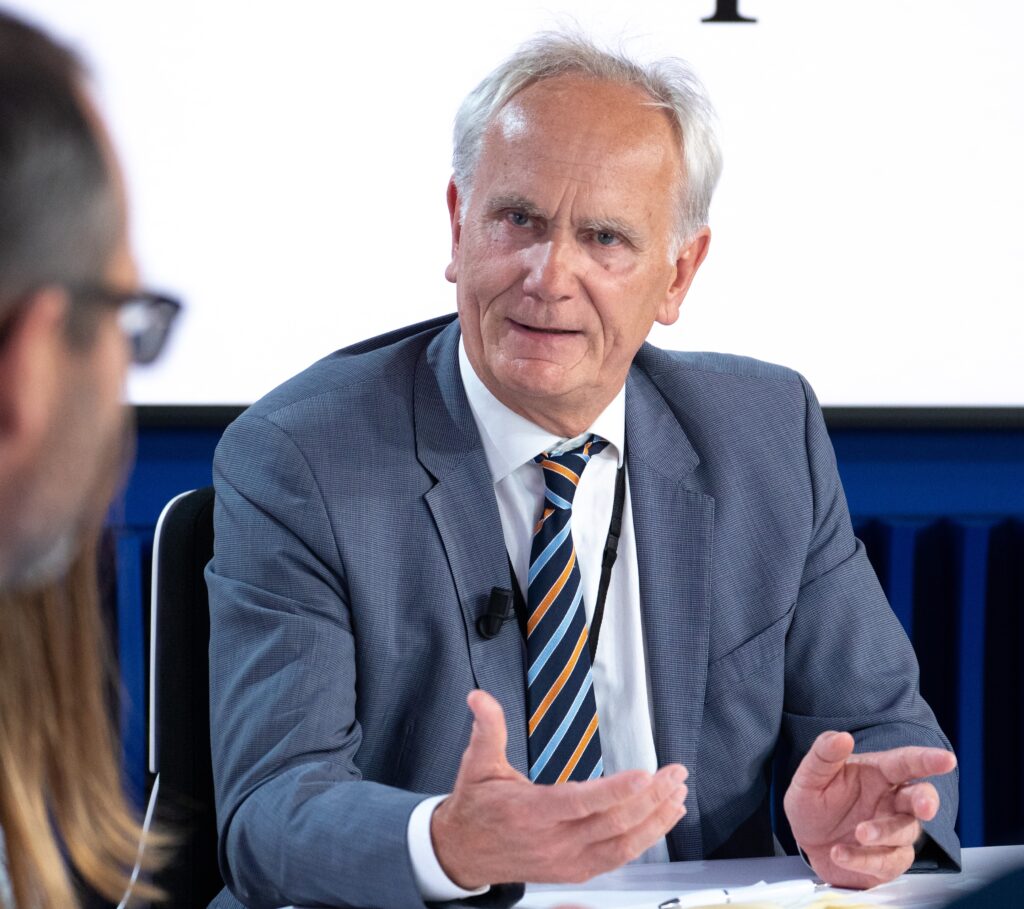
 Burkard Schmitt, Security and Defence Director of ASD Europe, in the EU Perspectives defence podcast / Photo: EP
Burkard Schmitt, Security and Defence Director of ASD Europe, in the EU Perspectives defence podcast / Photo: EPDangerous bargain
Instead, the continent drifted into what he terms a “voluntary dependence” on American hardware. Purchases of F-35 jets or Patriot missile systems have often been justified not just by their technical superiority but by the perceived guarantees they conferred. “It is not only because the equipment is so well performing, it is also that you think you buy the security guarantee that comes along with this. So you make yourself dependent to make sure the US will eventually help you,” Mr Schmitt observed—and was quick to point out the risks associated with such an approach.
“This is, of course, a dangerous bargain. We have seen it in the energy sector, with the dependency on Russia. So being dependent can backfire,” Mr Schmitt warns, referencing the scramble to replace Russian gas after 2022. The war in Ukraine has underscored the perils of outsourcing defence capabilities. “If you don’t have a resilient industrial base, you’re vulnerable,” he argues.
The solution, he suggests, lies in redefining defence industries not as mere economic actors but as defence capabilities integral to sovereignty. “We need to ask: what technologies must we control to safeguard strategic autonomy?” For Europe, his own answer to the question includes critical areas like missile defence, satellite communications, and cyberwarfare—sectors where reliance on external suppliers could prove crippling in a crisis.
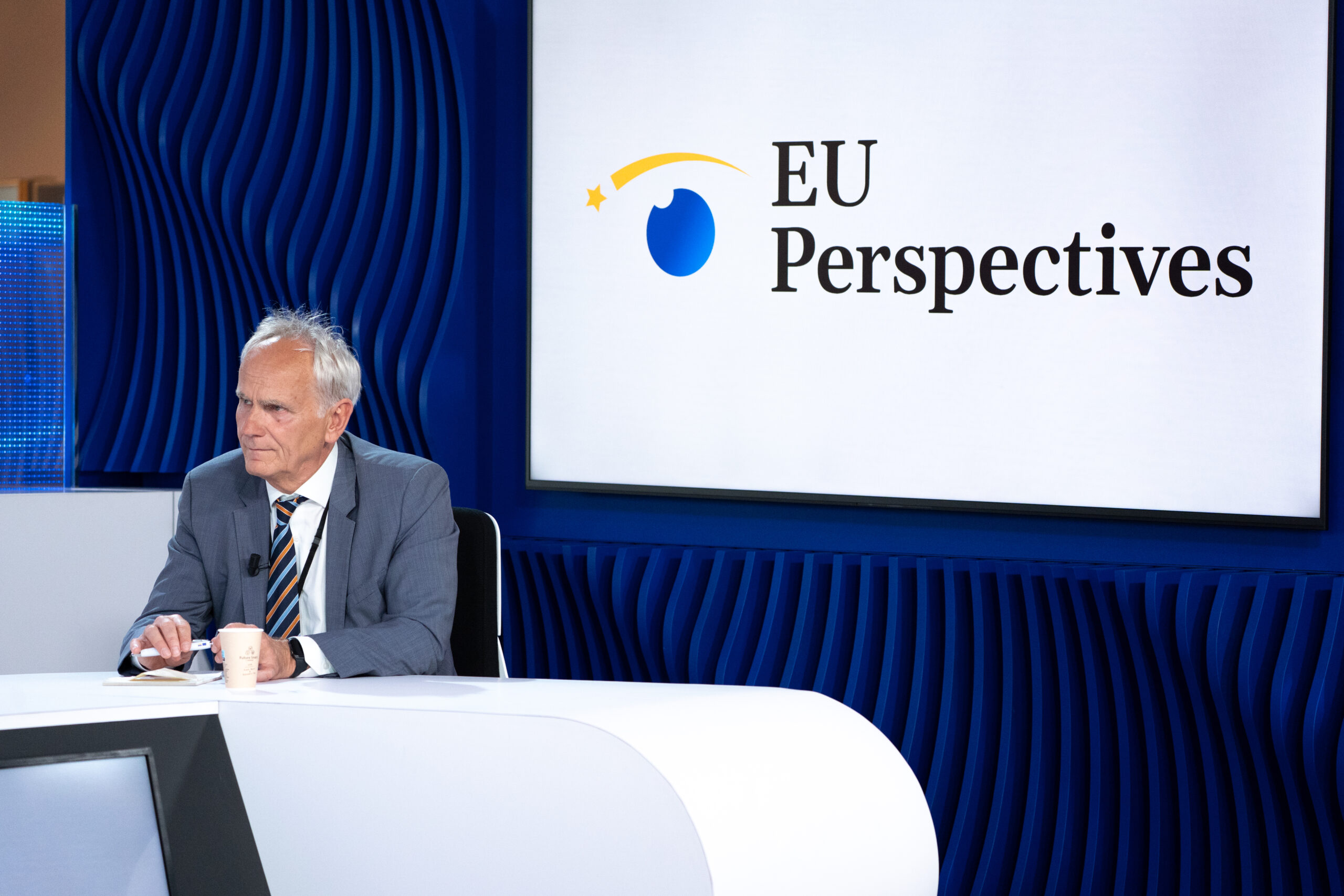
 Burkard Schmitt, Security and Defence Director of ASD Europe, in the EU Perspectives defence podcast / Photo: EP
Burkard Schmitt, Security and Defence Director of ASD Europe, in the EU Perspectives defence podcast / Photo: EPJoint procurement imperative
The case for pan-European procurement is compelling but fraught. Aggregating demand across member states could lower costs, streamline supply chains, and foster interoperability. The success of Airbus, a symbol of European industrial collaboration, looms large in these discussions. “Airbus shows integration can benefit all. We don’t need an Airbus for defence everywhere, but it sets an example,” Mr Schmitt said.
Yet defence collaboration has historically foundered on national rivalries and differing threat perceptions. (The Future Combat Air System, a Franco-German-Spanish sixth-generation fighter jet, has been plagued by disputes over workshare and export controls. Similarly, the European Patrol Corvette programme, involving Italy, France, Spain, and Greece, has progressed fitfully.)
Mr Schmitt acknowledges these tensions but insists consolidation is inevitable. “In every process, there are winners and losers,” he said. “But industry will adapt.” Smaller national champions, he argued, could specialise in niche technologies or form joint ventures to compete globally. The alternative—a fragmented market of 27 mini-industries—would leave Europe outgunned by American and emerging Chinese suppliers. “Without critical mass, we cannot compete,” he stressed.
MEP Jan Farský (EPP/CZE), another podcast participant, agreed. “I think that we have to try to introduce change on all of these topics. Otherwise, we will stay vulnerable. And I don’t want to live in an unsafe Europe,” he said.

Supply chain bottleneck
Even if political hurdles are overcome, scaling production presents formidable technical challenges. Since 2022, EU nations have announced a flurry of orders—from artillery shells to air-defence systems—but translating these into industrial output requires time and certainty. “Announcements alone won’t suffice,” says Mr Schmitt. Defence firms face pressures to avoid overextending without binding contracts. “There is only a certain point to which you can (invest into a vague promise). Because these are defence companies, and most of them are listed on the stock market. So you have to fulfill certain criteria vis-à-vis your investors. And you cannot take unlimited risk.”
The complexity varies by sector. Ammunition production, though simpler than building fighter jets, has exposed critical bottlenecks. The EU’s pledge to supply Ukraine with one billion artillery shells within a year fell short, with only half delivered on time. Ramping up output required restarting dormant production lines, sourcing scarce raw materials like explosives, and re-engaging subcontractors who had shifted to civilian markets after the Cold War.
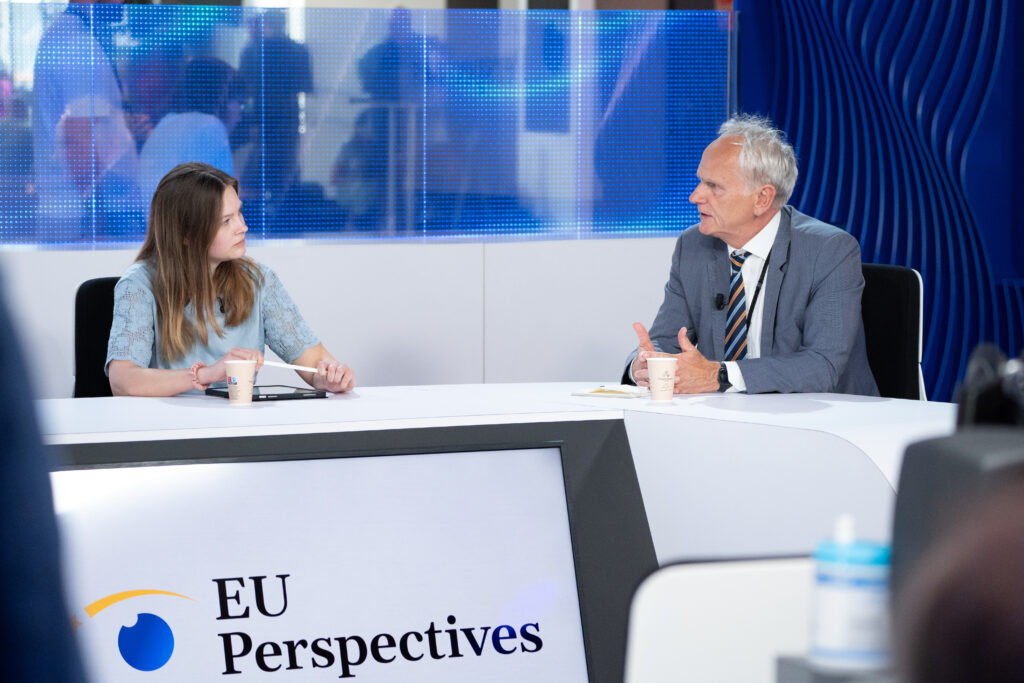
Time and trust
“These companies have enormous ecosystems of sub-suppliers,” Mr Schmitt noted. “Mobilising them takes time and trust.” (For more complex systems, the challenges multiply. A single Leopard 2 tank relies on over 8,000 components from hundreds of suppliers across Europe.)
Small and medium-sized enterprises, which comprise over 60 per cent of Europe’s defence supply chain, are particularly vulnerable, said Mr Schmitt as a senior figure of ASD, representing such companies (and one-time collaborator of the European Commission in the field). “If you’re a family-owned firm making tank treads, you can’t gamble on promises,” he said.
Startups, meanwhile, face a different hurdle: attracting risk capital. While innovations in drone swarms or AI-driven surveillance—born of lessons from Ukraine—have sparked investor interest, many financiers remain wary. “Defence was seen as unethical,” Mr Schmitt explained. “Banks once refused to open accounts for defence firms.“ However, times have changed, he says; now, the banks are likelier to enquire how to navigate classified data or export controls.
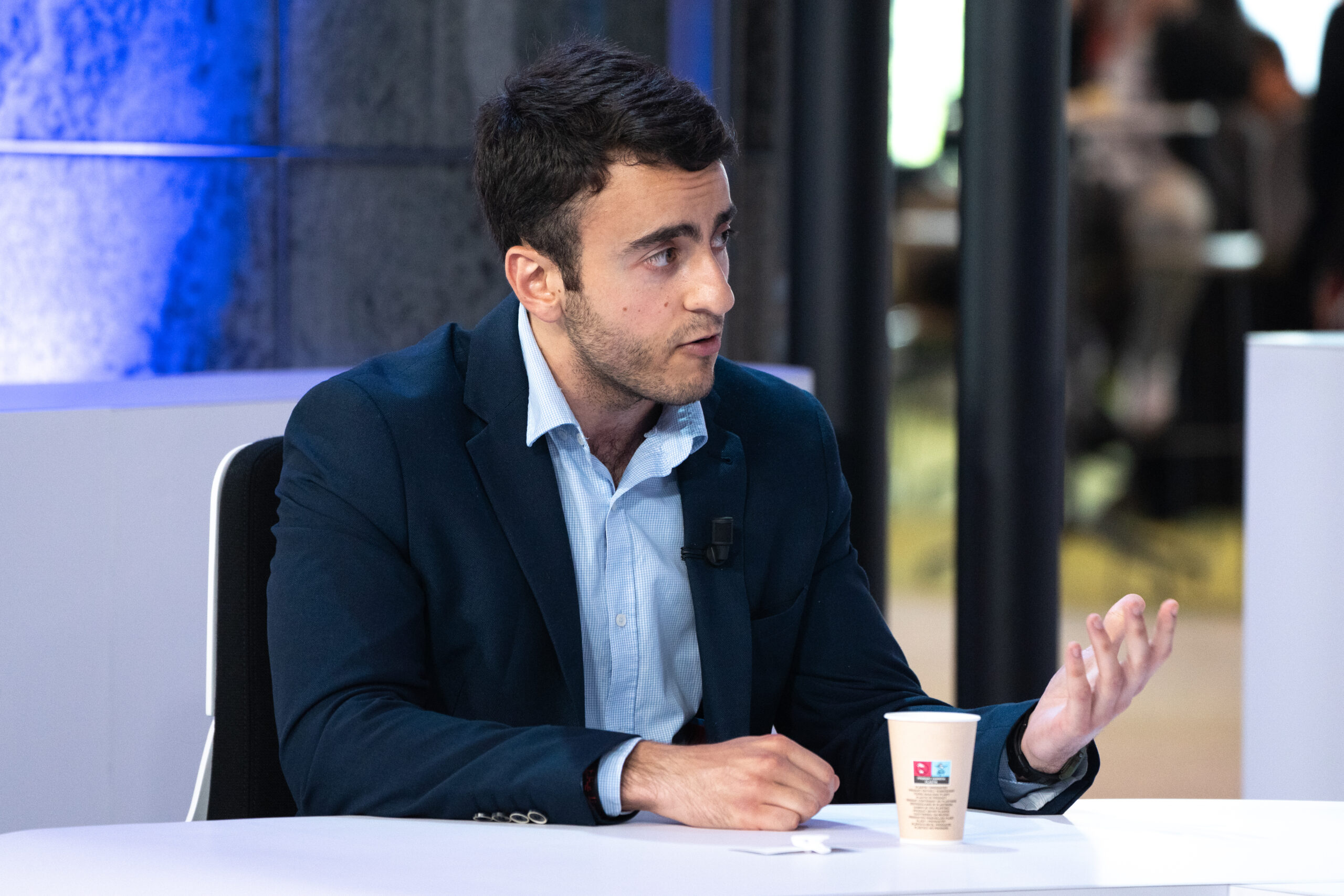
Shifting Sentiments
The role of private investment is evolving but remains a point of contention. “The issue on the supply seems to be rather minor in terms of exactly tackling the financing problems for SMEs,“ said another debater, Bruegel research analyst Juan Mejino-López, in favour of private capital providing the necessary upfront investment.
“Public spending is irreplaceable,” Mr Schmitt replied. “You do need governments to buy the equipment.” Yet private capital can accelerate innovation if regulatory and cultural barriers are addressed, he said.
The European Investment Bank, for instance, still excludes “hardcore defence” projects from its lending portfolio, a policy Mr Schmitt calls “outdated.” “When even the EIB shuns defence, it sends a signal,” he says. Smaller lenders often follow suit, leaving businesses scrambling for alternative funding.
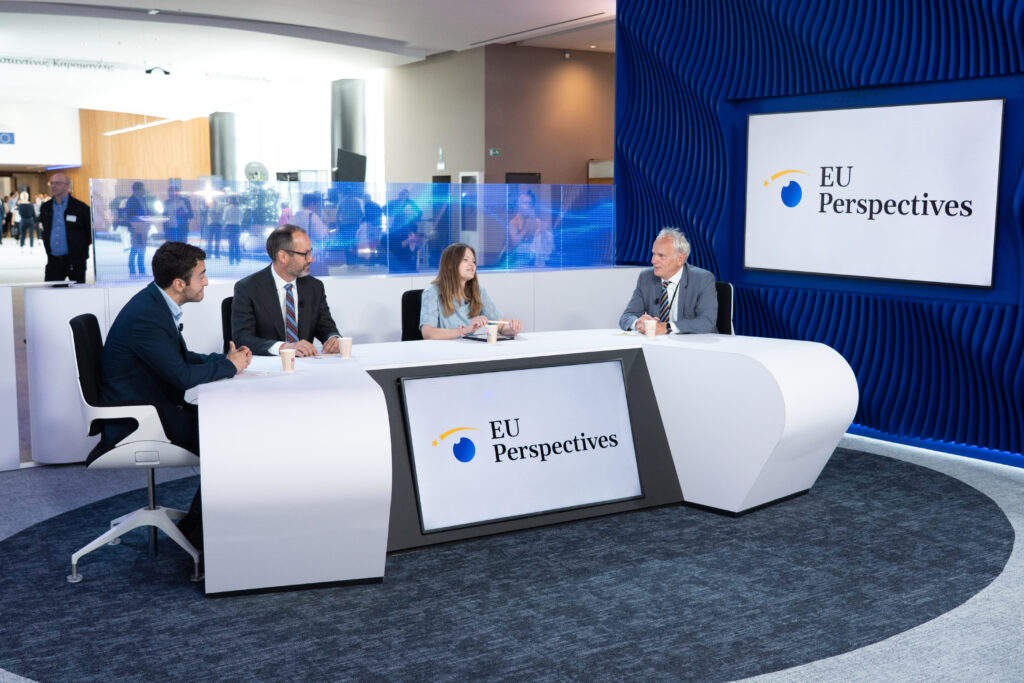
Contracts, not declarations
There are glimmers of progress. Institutional investors, eyeing surging defence budgets, are warming to the sector. Private equity firms like KKR and Bain Capital have acquired stakes in European defence contractors, while venture capital flows into dual-use tech startups. “Two years ago, we had to convince investors defence was ethical,” said Mr Schmitt. “Now, they want sectoral expertise.” The U.S. Foreign Military Sales (FMS) programme—a one-stop shop for allies to buy American gear—offers another lesson. “FMS is fast and predictable,” he noted, indicating that Europe’s procurement is neither.
In other words, it is binding contracts that matters, not political declarations. “Procurement systems must become faster, leaner, meaner. Member states must commit to multi-year orders,” Mr Schmitt said. Without synchronised demand, Europe’s defence sector will remain a collection of disconnected parts—capable of producing excellence in niches but lacking the coherence to deter 21st-century threats.
The stakes extend beyond military capability alone. A robust defence-industrial base, Mr Schmitt argues, is inseparable from technological sovereignty. “The same factories building missiles today could build quantum sensors tomorrow,” he says. “Lose one, and you risk losing both.” As geopolitical tensions mount, Europe’s ability to defend its interests—and its values—may hinge on whether it can finally transcend the peacetime mindset that still lingers, like a ghost, in its defence boardrooms.

